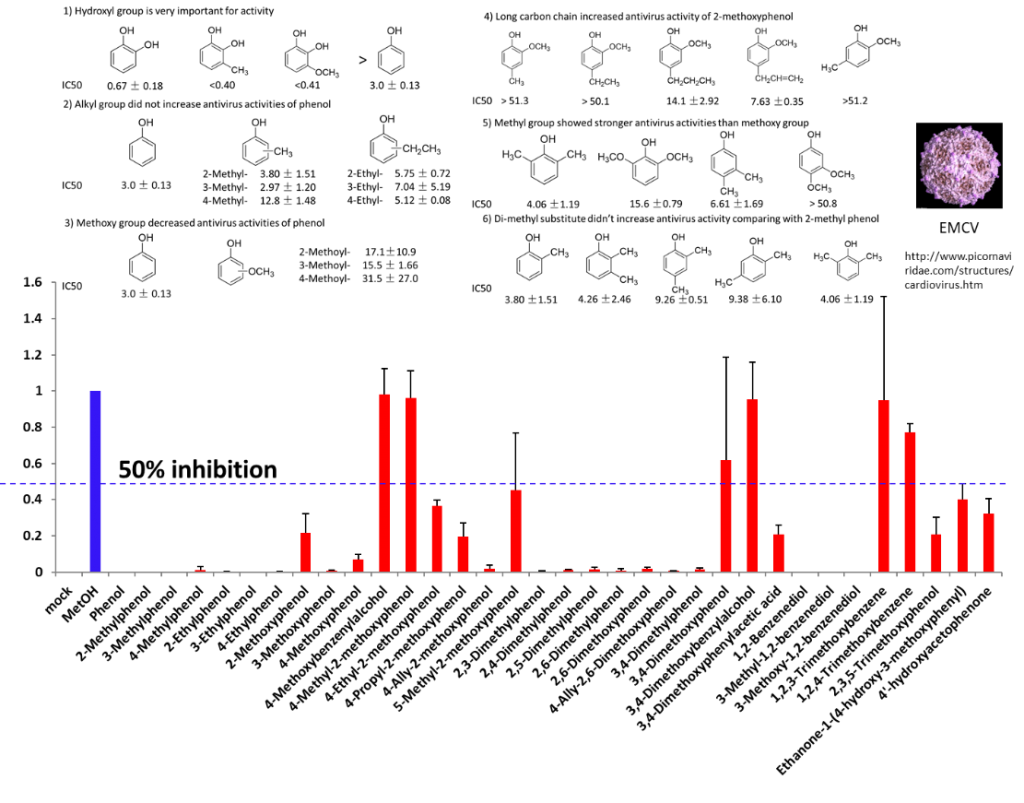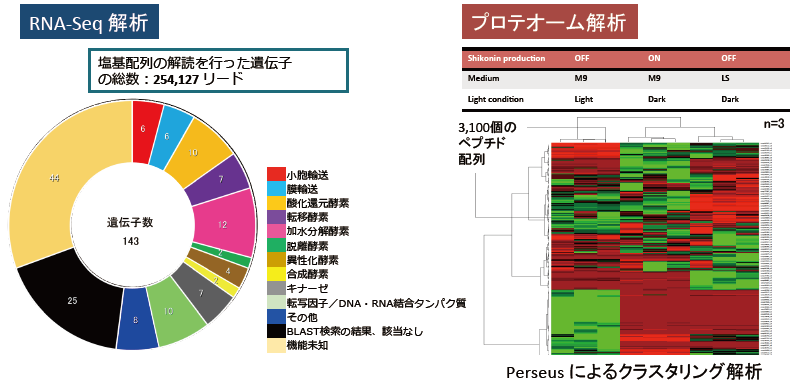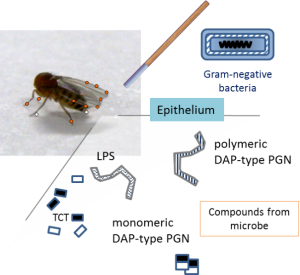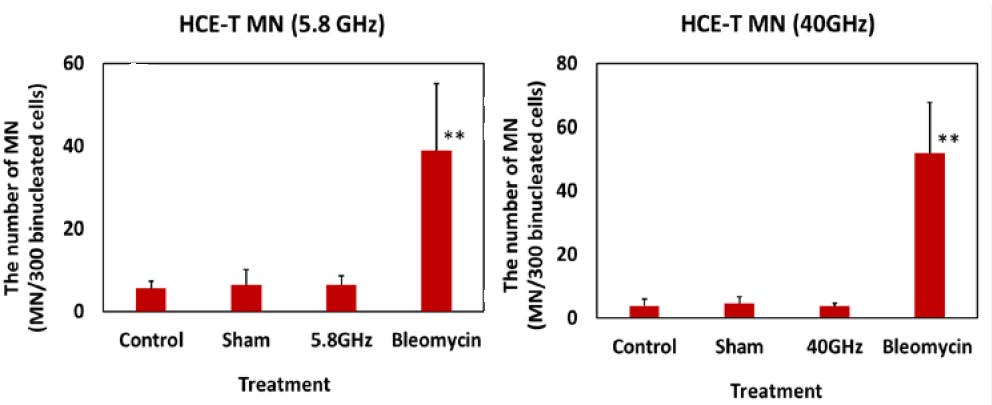2017 Activity Report for Mission 5-1: Harmonization of Human Health and the Environment
Updated: 2018/06/20
< Bioactive compounds>
Research 1-1: Survey of antiviral compounds from wood and bamboo vinegar (Takashi Watanabe)
Joint studies on antiviral compounds from wood and bamboo vinegars have been conducted, with the goal of contributing to human health and life by producing medicinal and biologically active substances from unutilized biomass. In FY2017 we published a paper on antiviral phenol derivatives in wood and bamboo vinegar. The effects of substituents attached to the aromatic skeleton on antiviral activity were elucidated. We started the joint research to produce antitumor and antiviral compounds by degrading wood and sugarcane bagasse by microwave reactions.
Antiviral activity of phenol derivatives from wood and bamboo vinegar against EMCV
Publications, etc.
- Li, R. Narita, R. Ouda, H. Nishimura, S. Marumoto, M. Yatagai, T. Fujita, T. Watanabe, ACS Sustain. Chem. & Eng., 6, 119–126 (2018).
- Li, Narita, R. Ouda, S. Marumoto, H. Nishimura, T. Fujita, T. Watanabe, Characterization of antiviral compounds in wood and bamboo vinegars, International Workshop on Bamboo Charcoal & Vinegar, Zhejiang, China, Dec.13. 2017.(Invited lecture)
Research 1-2: Production mechanism of bioactive compounds and biotechnology (Kazufumi Yazaki)
Many plant secondary metabolites utilized in clinical fields have strong lipophilic properties, e.g., vincristine and paclitaxel serving as anti-cancer drugs, while their secretion mechanism from the cells are largely unknown. In this study, we are attempting to elucidate the molecular mechanism of lipid secretion from plant cells, utilizing shikonin producing system as a model.
In 2017, we conducted transcriptomic and comparative proteomic analyses using shikonin-producing and non-producing cultured cells of Lithospermum erythrorhizon, to find out DNAs and peptides that are specifically expressed under shikonin producing condition. As a summary, we made a list of candidate genes potentially involved in the biosynthesis and the secretion of shikonin derivatives from this plant.
Publications, etc.
- Ueoka H., Miyawaki, T., Sasaki, K., Ichino, T., Yamamoto, K., Ohara, K., Suzuki, H., Shibata, D., Yazaki, K., “Functional analysis of geranyl diphosphate synthase localized in cytosol in Lithospermum erythrorhizon” The 2nd Asia Research Node Symposium on Humanosphere Science (Kyoto)
- Tatsumi K., Okazaki, Y., Kajikawa, M., Ichino, T., Saito, K., Fukuzawa, H., Yazaki, K., “Secretion of lipids from Lithospermum erythrorhizon cells and its relevance to shikonin production” The 59th Annual Meeting of the Japanese Society of Plant Physiologists (Sapporo).
- Ueoka H., Miyawaki, T., Sasaki, K., Ichino, T., Yamamoto, K., Ohara, K., Suzuki, H., Shibata, D., Yazaki, K., Characterization of Geranyl Diphosphate Synthase (GPPS) in Lithospermum erythrorhizon、JSBBA KANSAI 4th Student Forum (Kobe)
Research 1-3: Establishment of unit reaction for biological production of antitumor lignans (Toshiaki Umezawa)
Lignan is a class of phenylpropanoid dimers liked via C8-C8′ side chains of two phenylpropane units. Lignan has various biological activities. Among them, podophyllotoxin is an anti-tumor lignan and is expected to be established a sustainable production system using bioproduction. In this study, we attempted to clone cDNAs involved in the antitumor lignan to achieve the bioproduction system,
On the other hand, lignans are metabolized to mammalian lignans with unique aromatic substitutions by human intestinal bacteria. The high concentration of mammalian lignans has been known to reduce the risk of chronic diseases such as breast cancer. However, the enzymes involved in mammalian lignan formation remain elusive. In this FY2017, we have challenged to clone and characterization of podophyllototixin biosynthetic genes and to identify enzymes involved in mammalian lignin transformation.
Publications, etc.
- Hisadome H, Suzuki S, Utsumi R, Umezawa T.: Search of a human intestinal bacterium, Blautia producta The 62nd Lignin Symposium, Nagoya, October 26-27, 2017 (Poster)
- Hisadome N, Suzuki S, Utsumi R, Umezawa T: Search of lignan O-demethylation involved in mammalian lignan production. The 68th Japan Research Society of Wood Science, Kyot,o, March 14-16, 2018 (Oral)

Proposed biosynthetic pathways for antitumor lignans
Research 1-4: Insect model to discover physiologically active substances in biomass (plants and microorganisms) – searching for gene resources though grooming behavior – (Aya Yanagawa)
Animals groom themselves or each other. It appears, for example, that leg shaking in humans is a grooming behavior. Hence, the factors involved in grooming regard important to abnormal behaviors from stress or cardiac disorders. We would like to contribute medical treatments that can ease abnormal behaviors by clarifying the genes or chemical factors involved in grooming using an insect model. In 2017, we have found that the grooming reflex in decapitated flies was only induced by the signal from gram-negative bacteria, and it relied on PGRP-LC, which is the receptor gene for gram-negative bacteria. PGRP-LC is important not only for insect innate immunity called IMD but also human immune-system. As for fungi, the data from the mutants of Or83b (for olfaction) and poxn 70 (for gustation) indicated that Drosophila mainly used olfactory and mechanical signals to clean them, but not gustation.
Research Activities
- Yanagawa, A., Chabaud, M-A., Imai T., Marion-Poll, F. Drosophila usage of chemical cues in removing fungus Beauveria bassiana from the body surface, The International Congress on Invertebrate Pathology and Microbial Control and the 50th Annual Meeting of the Society (August, 2017, San Diego).
- Yanagawa, A., Yoshimura, T., Hata, T. Raman spectra of Drosophila chemosensory wing hair, 39th Annual meeting of Japanese society for comparative neurophysiology at Fukuoka (November 2017, Fukuoka)
Publications
- Yanagawa, A., Chabaud, M., Imai, T., Marion-Poll, F. (2018) Olfactory cues play a significant role in removing fungus from the body surface of Drosophila melanogaster, Journal of Invertebrate Pathology151, 144-150.
- Yanagawa, A., Neyen, C., Lemaitre, B., Marion-Poll, F. (2017) The gram- negative sensing receptor PGRP-LC contributes to grooming induction in Drosophila, PlosOne 12(11), e0185370.
Research 2: Biological effects of electromagnetic fields (Junji Miyakoshi)
There exists a wide variety of non-ionizing radiation (electromagnetic fields, EMF) in human living environments. There is increasing international discussion about the health risks of EMF exposure. We performed a risk assessment of EMF exposure using cellular and genetic examinations.
- Biological safety assessment of environmental EMF (millimeter waves, terahertz frequencies) fields.
- Biological safety assessment of EMF from wireless power transfer systems in human living environments.
In order to examine the effects of microwave electric feedings to tracks and scanners at airports on human cells, the genotoxicity was evaluated by exposure to 5.8 GHz and 40 GHz using cultured cells (HCE-T cells) derived the surface of the human eye.
The results of micronucleus formation (MN) test of HCE-T cells are shown in Fig. 1. MN frequency in cells exposed with 5.8 GHz and 40 GHz EMF did not show any significant difference from control and Sham exposure in the normal incubator. As a positive control, a significant increase was observed in cells treated with bleomycin at a concentration of 10 μg / ml.
We observed no influence on MN formation frequency in HCE-T cells after exposure to 5.8 GHz and 40 GHz EMF. Therefore, we will examine new research from another functional aspect, for example, gene expression. We are also planning to conduct research at different frequencies that are expected to be versatile in the living environment.
Figure 1: MN Frequency by 300 cells in binucleated HCE-T cells after exposure to 5.8 GHz and 40 GHz, (** p<0.01, n=6)
Publication
Koyama, S., Narita, E., Shimizu, Y., Suzuki, Y., Shiina, T., Taki M., Shinohara N., Miyakoshi, J., Effects of long-term exposure to 60 GHz millimeter-wavelength radiation on the genotoxicity and heat shock protein (Hsp) expression of cells derived from human eye. Int. J. Environ. Res. Public Health, 13, 802, doi:10.3390/ijerph130808022016, 2016.
Research 3: Air quality issues in outdoor and indoor environments (Kenshi Takahashi and Masanori Yabuki)
Human activities increasingly influence the Earth’s climate and ecosystems. For instance, humans change the atmospheric aerosol loadings by emitting primary aerosol particles and a variety of trace gases that could be chemically transformed to give aerosol particles. Aerosol particles impact the Earth’s climate on a regional and global scale. Our study aims to develop in-situ and remote sensing techniques for observing trace gases and aerosol particles and their applications to outdoor and indoor measurements, which is closely linked to air quality issues in outdoor and indoor environments. In FY2017, we investigated the relationship between the in-cabin air quality of vehicles and the ambient air pollutants at roadside, by use of the portable instruments and sensors for monitoring aerosol particles.
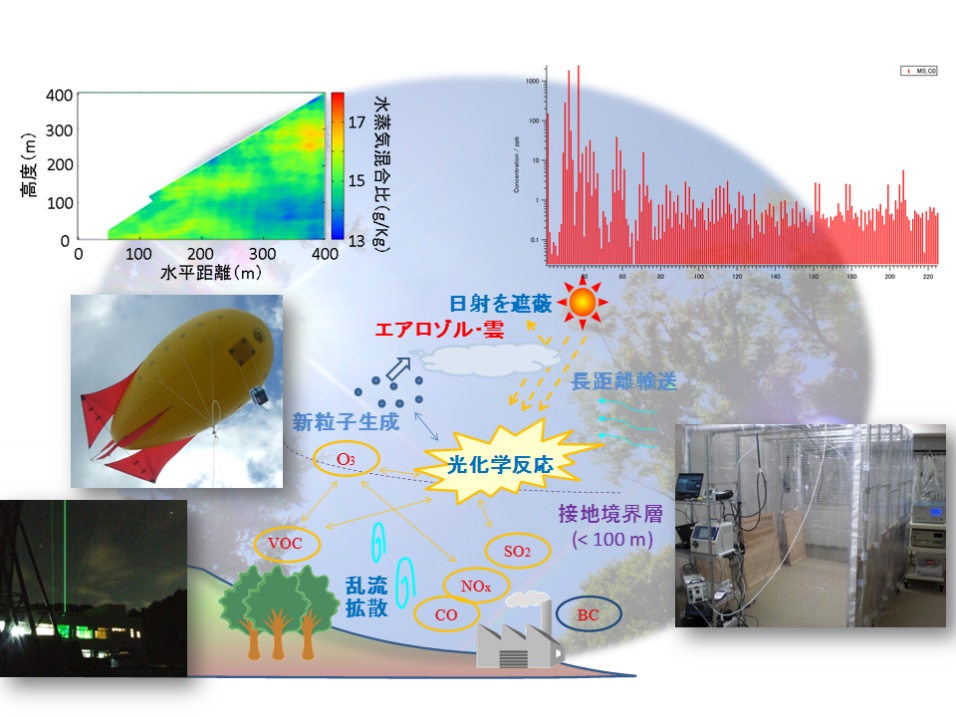
Development of new techniques for exploring spatio-temporal variations of atmospheric trace molecules and aerosol particles in outdoor and indoor environments.
Publications, etc.
- Yabuki, M., K. Miura, and M. Shiobara, Aerosol vertical profiles near Mt. Fuji using a micropulse lidar, Symposium on Atmospheric Chemistry and Physics at Mountain Sites 2017 (Gotenba, Japan), C-04, Nov. 2017.
- Yabuki, M., F. Kitafuji and T. Tsuda, High Spatial Resolution Aerosol Lidar with a Multispectral Detector, The 10th Asian Aerosol Conference (Jeju, Korea), PS-IM15, July. 2017.


